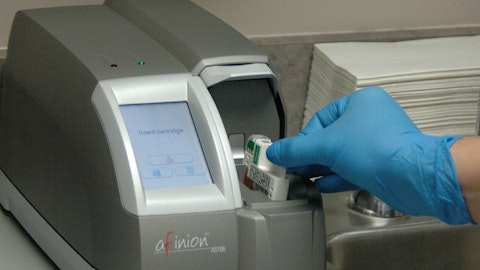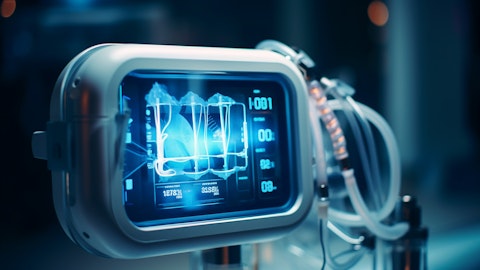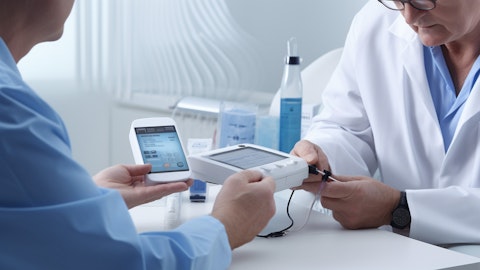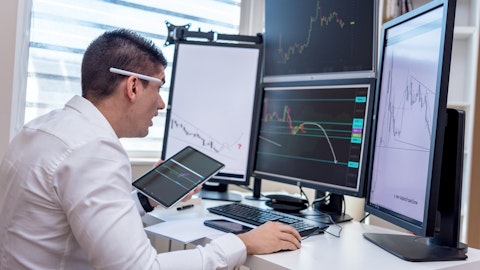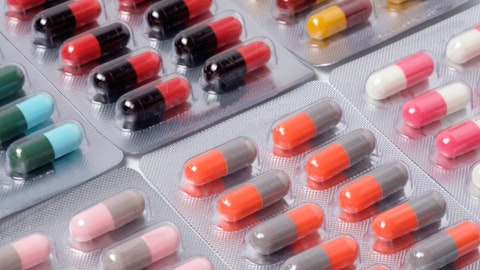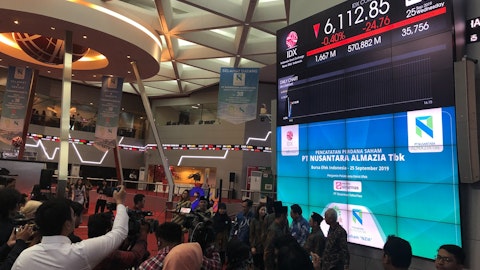We don’t have perfect insight into it out of the various available data. But we can see we’re reaching more and more health care practitioners. And that’s we believe we’re doing that through word of mouth, through our promotion activities, which include both direct-to-patient activities and also direct-to-physician promotional activities online. And then the other thing I’ll say is that it’s been very, very powerful for us, sort of along the same lines. The Omnipod GO commercial pilot has proven to be a terrific investment for us this year because what we’re learning — we’re learning a lot more about what happens in the primary care channel for people living with diabetes. And just a couple of things we’re seeing, we’ve learned a lot about the target patient population for Omnipod, we’ve learned that primary care practices when they think pump, they think the [indiscernible] thing with a tube that they would never prescribe and then when they see Omnipod, there’s a little bit of a head dynamic, and they say, “Wait, you know what, that’s so easy.
My patients could do that. We could do that.” And so we’re very confident we’re going to be able to drive demand for the Omnipod platform across primary care. And I think we’re seeing more type 1 patients than we anticipated in the primary care channel. So to your point, we’re very optimistic that as we continue to drive learnings out of our Omnipod Go pilot, we’re going to be able to find a new kind of new avenues for driving demand for Omnipod and really driving pod therapy — Omnipod therapy into the world where patients need it most. And so we’re very optimistic about that. And so we continue to see that trend as a positive signal for us, but we’re really excited about what we’re learning out in the world with our commercial pilot as we go.
Operator: Your next question will come from the line of Josh Jennings with TD Cowen.
Josh Jennings: I was just hoping to better understand pricing dynamics through the pharmacy channel in the U.S. for Omnipod 5 and DASH. Was reimbursement stable that Insulet was receiving for Omnipod 5 and Omnipod DASH in ‘23? And how should we factor in reimbursement levels and pricing for Omnipod 5 and DASH in 2024?
Lauren Budden: Yes. So really, it’s more about a volume business at this point. We did get a big price lift throughout 2023 from the conversions into the pharmacy channel. But as we’ve mentioned previously, those conversions are largely complete by this point. So we’re not seeing that going forward. We did have a price increase like we normally do in early September, which was pretty minimal. It’s just under 3% kind of in line with the cost of living adjustment. So just keep in mind there, though, we don’t see the full benefit of that because some of it goes to the DDM in terms of rebates and to the wholesaler fees. So at this point, for 2024, I would pretty much say that you should focus on the volume, not the price has leveled off. The great news is that we are getting that continued price lift going forward, but it shouldn’t be an incremental change.
Operator: Your next question comes from the line of Joanne Wuensch with Citi.
Unidentified Analyst : This is Anthony on for Joanne. 2024 is kind of investment year, maybe 2025 as well. But can you talk over the longer term, 2026 and beyond where gross margins and operating margins potentially could go and how you get there?
Lauren Budden: Yes, I’m happy to start off and then Jim feel free to add on. Yes, we definitely feel like we have room for expansion, both on margin and gross margin in the near term and in the longer term. We did great in Q4, and we have lots of opportunities as we’re setting up with the product launches that we have this year that will accelerate the top line and be able to allow us to drop more through. We haven’t put out guidance beyond 2024, but we are planning on doing a long-range plan later in this year.
Operator: Your next question will come from the line of Matthew O’Brien with Piper Sandler.
Matthew O’Brien: It is going to be one question, I promise. The first part is just more clarification kind of to Larry’s question earlier, but I’m looking at the stock down kind of mid- to upper single digits in the aftermarket. I think it’s on this guidance commentary. And again, the high end of the range gets you to that 25%. Was it a street modeling issue at 25% versus where it should have been 23%, 24%. I’m just making sure there’s nothing competitively or pharmacy related that we should really be worried about? And then the real question is, Jim, when you guys came out with O 5, I think you went from 80/20 MDI to competitive conversions all the way to 60-40, and then it went to 70-30, now we’re back to 80-20. Is it getting tougher and tougher to take those competitive conversions? And with G7, do you think that will start to get a little bit better, a little bit easier throughout the course of this year?
Jim Hollingshead: Why don’t — we’ll have Lauren start on the guide and then I’ll pick up on the competition. Go ahead, Lauren.
Lauren Budden: Sure. So for 2024, even with the significant volume benefit that we realized in ’23, we’re guarding to very strong revenue growth. We expect to achieve almost $2 billion in revenue and our guide represents $300 million of revenue growth in terms of dollars. So your question in terms of what changed from the call we provided, it was really just that revenue shift of 20 million to 25 million of orders that were — would have been Q1 but were placed in advance of our ERP implementation. So the estimated impact of that is 3 points on the total company and 4 points on U.S. Omnipod. So overall, our guide is strong. And as we’ve mentioned, we have many catalysts for growth in ’24 that’s going to help accelerate it and particularly in the back half with those new customer starts and provide strong revenue growth for the year and into 2025 and beyond.
Deborah Gordon: I’m sorry, Jim. I was just going to say that, you nailed it. I thought I heard you say that U.S. The Street is modeling now 25% on a normalized basis. So if I got that right that you said that the U.S., that’s exactly right for the year on a normalized basis. And Lauren nailed it when she said the 4-point impact. So when Lauren provided some color on the Q3 call that we would be in mid-20s to referring to 24 to 26 around there. And at the midpoint, we’re spot on what we were expecting for U.S. And that’s about — if you do the math, about 21% on a normalized basis for total Omnipod and it gets you to the total company growth of 20%. So it’s spot on from the color that Lauren gave in November. We just didn’t expect that shift, which is the $20 million to $30 million shift that happens, ends up or $20 million to $25 million ends up being double, right, to the 40 to 50 because it’s comes out of one year and goes into the other.
So that’s where actually she was trying to normal set. So hopefully, that answers your question on that piece. Sorry, Jim
Jim Hollingshead: And we can always clarify this offline, right? So — but it’s a decrease in the denominator, increase in the numerator for ’24, you get the normalized number, right? So it’s a double whammy in that $20 million to $25 million. So the underlying guide remains the same, respectively. On the competition, yes, we continue to have really good new customer starts. And historically, we always had 80/20 of MDI and competitive switching. After the launch of Omnipod 5, we obviously caught a lot of competitive switchers, and we’ve done really, really well. We continue to have. So if you think about pre-Omnipod-5 and that 20% of competitive switches and with Omnipod 5 and 20% of competitive switchers, it’s a larger number than it was, right?
So because new customer starts are up overall, so we continue to do very, very well. And the underlying dynamic there is we also retain the vast majority of customers that we get from competitors. Retention is very, very strong. And we said that, we do think — we had the benefit now of hearing our two competitors’ calls, and we have the benefit of seeing what’s happening out in the market. We don’t see — there’s little things around the edges, I would say. We don’t see any fundamental underlying shift in the competitive dynamic. Omnipod 5 continues to be the preferred product. But I would say that one of our competitors has done a better job of staunching the bleeding in their installed base. And so you can see a little bit of that dynamic going on in the market.
But we’re still clearly the preferred offer — clearly winning with MDI and just winning with new customer starts overall very, very clearly in the market.
Operator: Your next question comes from Mike Kratky with Leerink Partners.
Mike Kratky: So you’ve capitalized on having a competitive advantage in type 2 with broad pharmacy access. How are you planning on defending that position in the market as we start to see additional pumps expand into the pharmacy channel on both a near-term basis and then looking ahead to 2025?
Jim Hollingshead: Great question. Thank you. Pharmacy is — our offer — the Omnipod platform offer is much better suited to the pharmacy channel than tubed pumps are, much, much better suited. 2 pumps at the end of the day, continue to be durable equipment. And there’s all kinds of things that I can go into the weeds here and talk about this, but I’ll just say it’s not a surprise that we see competitors trying to figure out how to get in the pharmacy channel with a durable tube pump because we’ve been so successful in establishing the pharmacy channel for AID. And as we would expect, competitors are — we’ve established market leadership across basically the whole range of our offer and competitors are going to chase that. It’s — there’s — what we’ve learned is, there’s a very big learning curve in pharmacy.
It’s very, very different from the DME channel, the economics work better for us because there’s — in all cases, the value is actually in the pump, whether it’s a durable pump or it’s the pod. And the fact that the value is created in our consumable, which is the pod gives us an inherent advantage as we — it starts to get a little abstract, but it gives us an inherent advantage as we’re in that channel. Couple that with the fact that we have very, very wide coverage in the pharmacy channel, we have established contracts across the PBMs. And we’ve had very successful growth with all of our PBM partners. We think we have a very defensible position there. People who use insulin go into the pharmacy to get their insulin, whether they’re getting it from retail pharmacy.
So it’s a great place for them to also get their AID-pump therapy and Omnipod continues to be very uniquely positioned and the value prop of Omnipod in the pharmacy channel will continue to be very uniquely positioned as we go forward.
Operator: Your next question will come from the line of Chris Pasquale with Nephron.
Chris Pasquale: Jim, your comments on what you’ve learned so far from the GO LMR were really interesting. It sounds like that’s going pretty well. But I think I heard the guidance really doesn’t assume any benefit from GO in ’24, which makes it sound like a full launch isn’t planned anytime soon. How are you thinking about the timing for a full launch? And what’s really the gating factor there? What boxes do you need to check before you’re ready to expand the commercialization?
Jim Hollingshead: Yes, great question. The way to think about Omnipod GO is that we hear a different language about this. And I’d just be really clear, we’re not in limited market release with GO, we’re in a commercial pilot, right? And so that’s a step before — I think I said this last quarter on our call as well, that’s a step before an LMR. The product itself is ready. It’s out on patients, it’s fully approved. We continue to grow coverage for it. So that’s a step but we’re ahead of schedule and coverage. So the way to think about the Omnipod GO commercial pilot is the gating factor is not timing, it’s learning, right? So what we’re using it for is to establish the right commercial model, both for GO and for the primary care chain.
And one of the reasons we’re so excited about the pilot is that we are learning an awful lot out of that pilot. And so — and where we’re going to land on this thing, whether we commercialize in ’24 with GO or commercialize — get to more of an FMR in ’24 or sometime in ’25, where we’re going to land is we’re going to be in the primary care channel first and second, one way or another, we’re going to have call points in primary care. And the other thing is we will have the broadest offering for people living with type 2 diabetes who need insulin delivery. So we’re already the market leader with DASH in that space very clearly. We know — we have our pivotal trial going to Omnipod 5. As we said before, we know Omnipod 5 is actually being used off label.
In a lot of cases, we’re not promoting Omnipod 5 off-label, but we’ll have — our goal is to have the label for Omnipod 5 in the short order coming out of our pivotal trial, and we continue to have a plan to file with the FDA for that label extension in ’24, and we’ll have Omnipod GO. And that gives you the whole coverage for people using insulin with type 2 all the way from I’m initiating basal insulin 2, I’m using intensive insulin. And so we’ll have that full portfolio of products, and we’ll have a very clear way to commercialize that in both primary care and in the endocrinology channel. So that’s why I’d say I’m very excited about the commercial pilot with Omnipod GO. We are learning the ton and it’s going to make us much better commercially as we get into that and get that full portfolio on market.
Operator: Our next question will come from the line of Steve Lichtman with Oppenheimer.
Steve Lichtman: As you start opening up the opportunity here to the Libre platform outside the U.S. and then in the U.S., can you give us your latest thoughts on the size of that opportunity. There’s been estimates on what that new opportunity set looks like. It would be great to get your latest color on that.
Jim Hollingshead: Yes. We think it’s a really big opportunity. If you look at the sensor market, you’ve got millions of people using Dexcom sensors and millions of people using Abbott’s sensors. So the G6, G7 family products and the Libre 2 and Libre — now emerging Libre 3 family products by creating the integration across that range. So prioritizing G7, prioritizing Libre 2 plus and then 3 that we’re working in parallel. It opens up a really large substantial market for us. The two — we love working with both of our partners. They both have great technology. They’re both really good partners. Development pathway with both of them is really strong. They’re slightly — they have slightly different positions in the main geographies of the U.S. and Europe in terms of their installed base, but both of them have very large installed bases.
